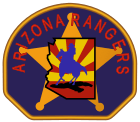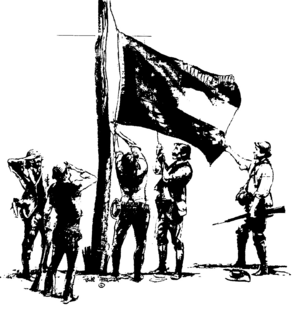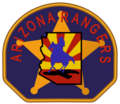Arizona Rangers facts for kids
Quick facts for kids Arizona Rangers |
|
|---|---|
 |
|
| Agency overview | |
| Formed | March 21, 1901 (initial) 1957 (revival) |
| Dissolved | 1909 (initial) |
| Volunteers | 400+ |
| Jurisdictional structure | |
| Operations jurisdiction | United States |
| Legal jurisdiction | Arizona |
| General nature | |
| Operational structure | |
| Headquarters | Tucson, AZ |
| Sworn members | 400+ |
The Arizona Rangers are a special group of volunteers. They are a non-profit organization that helps law enforcement in Arizona, USA. They do not get paid by the government.
In 2002, the State of Arizona officially recognized the modern Arizona Rangers. A state law was passed that allows them to help any police agency in Arizona. This includes local, state, federal, or tribal police. They can also provide security for many non-profit groups.
The first Arizona Rangers were formed in 1901. Their job was to get rid of outlaws and crime in the Arizona Territory. At that time, the area was very dangerous. The United States Congress had not allowed Arizona to become a state yet. This was partly because there was so much crime.
The Rangers were well-trained and had good equipment. They were very good at catching even the most dangerous outlaws. They became one of the best law enforcement groups in the country. They were like the famous Texas Rangers. Their main job was to find and arrest outlaws, especially near the Mexican border. By 1908, most outlaws were caught, gone, or had fled to Mexico. The Rangers were stopped for political reasons in 1909. Soon after, Arizona became the 48th state.
The Rangers started up again in 1957. They still serve Arizona today. They do not get money from the government. Each Ranger pays for their own training and gear.
Police departments often ask the Rangers for help. They assist with tasks like traffic control, watching areas, protecting crime scenes, and moving prisoners. Every hour a Ranger volunteers helps police officers. This gives police more time to protect communities. For smaller police groups, the Rangers make them much stronger. School districts also ask the Arizona Rangers to be Resource Officers in schools. Arizona Rangers can make arrests in certain situations. They have full arrest power when working with police agencies.
Many Rangers get special training for specific jobs. For example, some work with railroad police. The Tucson Company of the Arizona Rangers helps law enforcement in a bigger way. These Rangers get extra training and physical fitness. They are then approved to do special support jobs. This includes patrolling areas and riding with officers on calls.
Contents
History of the Arizona Rangers

The Arizona Rangers were created by the Territorial Governor in 1901. They were formed to fight crime so Arizona could become a state. People sometimes confuse them with older groups from the 1860s. But there is no real connection. Back then, the area was called the New Mexico Territory. In 1861, it joined the Confederate States of America during the American Civil War. Arizona did not become a US Territory until 1863.
Early Territorial Rangers
The very first Territorial Rangers were formed to police new gold towns. These towns grew quickly after gold was found in 1858. An Arizona historian, Marshall Trimble, said that Jack Swilling might have been Arizona's first Ranger. Jack Swilling was also one of the people who helped start the city of Phoenix.
Civil War Rangers
After the Confederate Arizona Territory was formed, Governor John Robert Baylor wanted more Rangers. He wanted them to be like the wartime Texas Rangers. These Rangers would be cavalry, meaning they rode horses. In January 1862, the first Confederate Ranger company was formed. It was called Company A, Arizona Rangers. Captain Sherod Hunter led this company. It had about 75 men, mostly from the new Confederate Territory of Arizona.
These Confederate Rangers had revolvers and muskets. They were chosen for their skills and ability to handle frontier life. In February 1862, Company A was sent to Tucson. Tucson was the largest town in western Confederate Arizona. It was an important spot to watch for Union forces. By taking Tucson, Governor Baylor wanted to protect citizens and claim western Arizona.
Some Confederate Arizona Rangers also fought in the New Mexico Campaign in 1862. They were part of the Battle of Glorieta Pass. This battle ended Confederate control of New Mexico. The Union army later drove the Confederates out of Arizona.
The Tombstone Rangers
Before the 1901 Arizona Rangers, there were other groups. Marshall Trimble also wrote about militia groups formed earlier. Governor Frederick Tritle allowed the first company of Rangers in Tombstone in 1882.
Modern Arizona Rangers
At first, only one company of Arizona Rangers was allowed. It had a captain, a sergeant, and up to twelve privates. In 1903, the group grew to twenty-six men. Many early Rangers were veterans of Theodore Roosevelt's Rough Riders. They were excellent horsemen, trackers, and shooters. They were supposed to work secretly, but they became well-known. They wore their badges proudly and had good weapons.
Besides dealing with cattle thieves and other outlaws, the Rangers helped with worker strikes. These strikes happened at mines in Arizona and Mexico. During the Cananea Riot in 1906, mine managers shot at striking Mexican miners. The miners fought back. Captain Thomas H. Rynning and a group of 275 men went to help. Many people were killed in the fighting.
On February 15, 1909, the Arizona government ended the Arizona Rangers. In their seven years, 107 men served as Rangers. The Governor tried to stop this, but the assembly voted against him. This was partly due to pressure from sheriffs in northern Arizona.
After the Rangers disbanded, many stayed in law enforcement. Harry C. Wheeler became sheriff of Cochise County. Thomas Rynning became the prison warden in Yuma, Arizona.
In 1940, seven former Rangers rode together in a parade. In 1955, Arizona allowed a small monthly payment for former Rangers. Five men qualified for this payment.
William MacLeod Raine wrote about the Rangers in 1905. He said the Rangers' work was hard and dangerous. Before them, lawless groups made the territory unsafe. No one's cattle were safe from thieves. But within a year, the small group of Rangers had cleared out hundreds of bad people. Many were killed, and others fled to Mexico. He said Rangers were recruited from cowboys and Roosevelt's Rough Riders. They had to be skilled riders and quick to catch people trying to escape. He noted that nine times out of ten, a Ranger would bring back their target, "dead or alive."
More About the Arizona Rangers Today
In 1957, a non-profit group called the Arizona Rangers was formed. Four original Rangers helped start it. The modern Arizona Rangers were officially recognized by Arizona in 2002. Governor Jane Hull signed a law for this. This law recognized their history but did not give them police powers.
Members get 24 hours of training when they start. They also have ongoing monthly training. Rangers must pass tests with their firearms, batons, handcuffs, and pepper spray.
Today, the Arizona Rangers are unpaid volunteers. They help law enforcement and the community. They have three main goals:
- Helping law enforcement when asked.
- Providing security for government and non-profit groups.
- Supporting youth and community services.
All their work keeps the traditions of the original Arizona Rangers alive.
The Rangers work across Arizona. They have about 20 local Companies. Each Company works semi-independently based on local needs. Each Company has a Captain who helps lead the statewide group. This allows them to adjust how they help their local area.
When someone wants to become a Ranger, they go through checks. This includes a background check and a physical check. Once accepted, they are on probation. They must complete training, supervised duty, and other requirements.
Leadership of the Rangers
The first captain of the Arizona Rangers was Burton C. Mossman. He had experience controlling cattle theft on a large ranch.
In July 1902, Mossman left to go back to ranching. Thomas H. Rynning took his place. The third and last leader of the original Arizona Rangers was Harry C. Wheeler.
The men of the Arizona Rangers were very skilled. Newspapers often wrote about their brave actions. Many of these stories are in a book called The Arizona Rangers.
Uniforms and Badges
The original Arizona Rangers did not have standard uniforms. This was because they were meant to work undercover.
The badges of the Arizona Rangers were first given out in 1903. They were solid silver stars with five points. They had blue writing and designs. These badges are now very valuable to collectors. An officer's badge had their name on it. Badges for other Rangers had numbers. When a Ranger left, they returned their badge. It could then be given to a new Ranger.
Popular Culture
- The Arizona Ranger was a black-and-white movie made in 1948. It starred Jack Holt and his son Tim Holt.
- In the 1965 film Arizona Raiders, Clint (played by Audie Murphy) becomes an Arizona Ranger. He tracks down outlaws near the Mexican border.
- In the 1976 film The Last Hard Men, Charlton Heston plays Captain Sam Burgade. He is a retired Arizona Ranger who hunts an outlaw seeking revenge.
- An Arizona Ranger is in the song "Big Iron" by Marty Robbins. This song was also used in the video game Fallout: New Vegas. Johnny Cash also recorded it later.
- The TV show 26 Men (1957-1959) told stories about the Arizona Rangers.
- The Arizona Territorial Rangers Reenactment Group performs historical reenactments.
- In the music video for Toby Keith's song "Beer For My Horses", Willie Nelson plays a retired Arizona Ranger.
- Author Ralph Cotton has written many adventure novels about a fictional Arizona Territory Ranger named Sam Burrack.
Fallen Rangers
During the time the Arizona Rangers were active, three officers died while on duty.
| Ranger | Date of Death | Details |
|---|---|---|
| Carlos Tafolla |
|
Died after a gunfight. |
| Jefferson P. "Jeff" Kidder |
|
Died after a gunfight in Naco, Sonora. |
| John W. Thomas Jr. |
|
Died after a shootout in Sierra Vista, Arizona. |
Images for kids


